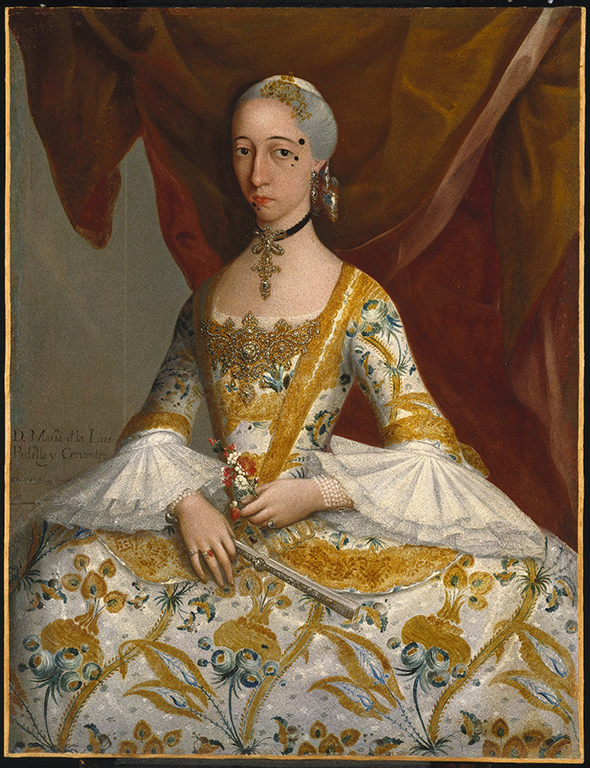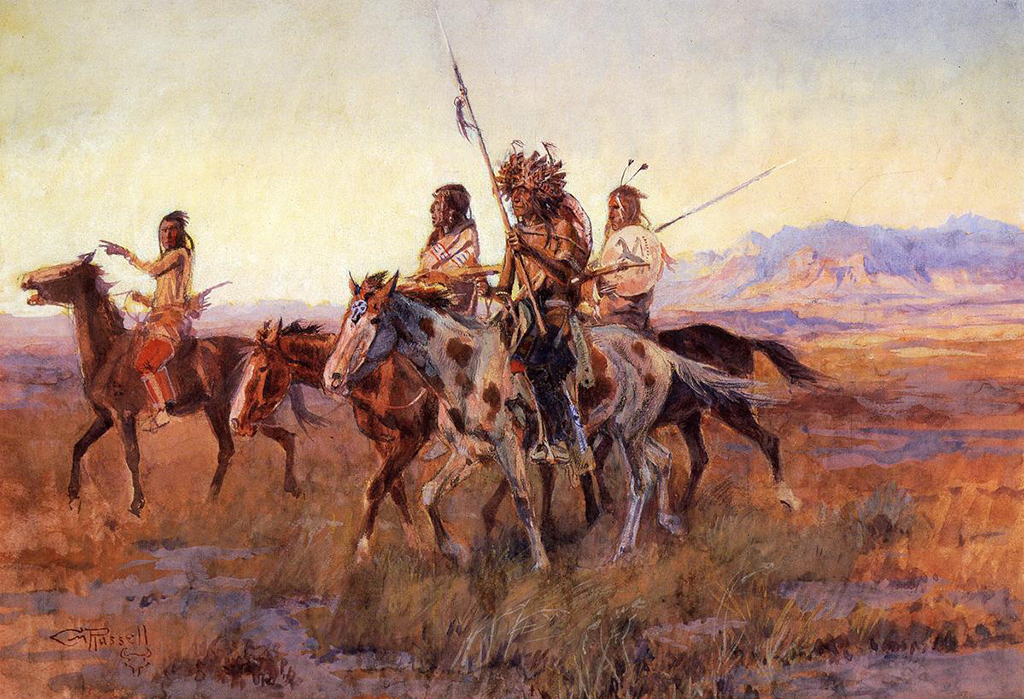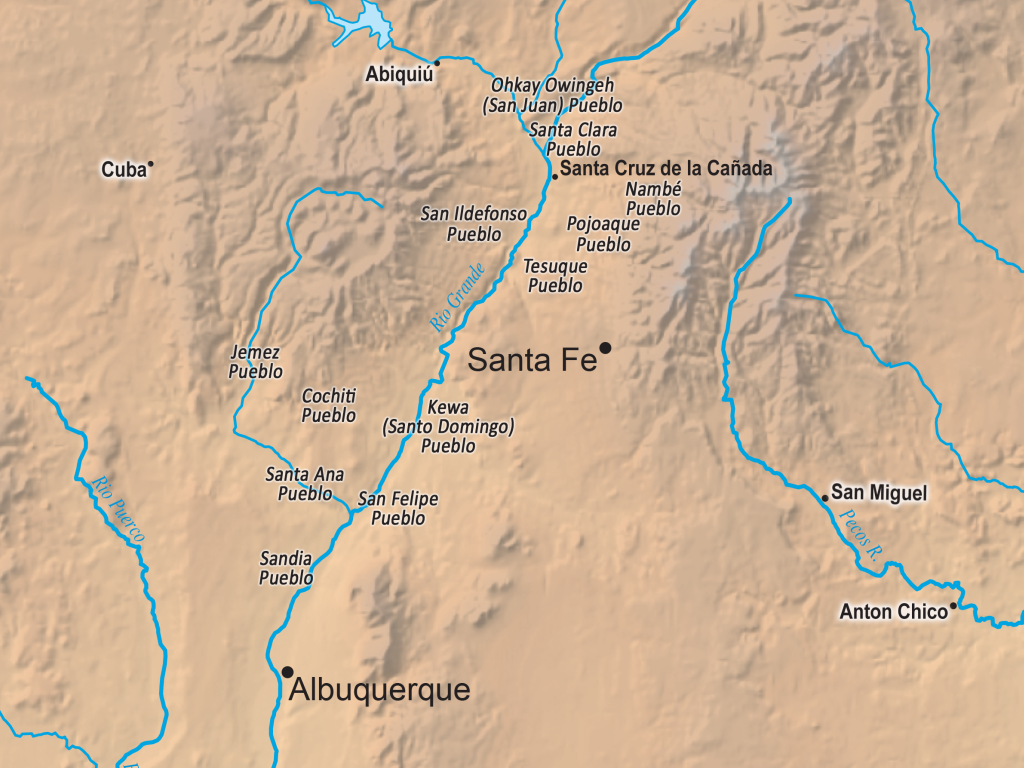The History of New Mexico
Collapse
Expand
-
Chapter 5: The Reconquest: Building a Durable Colonial Society
- The Reconquest: Building a Durable Colonial Society
- Waging Reconquest
- Renewing Spanish Colonial Society
- References & Further Reading
The actions of Governor Vargas and his supporters laid the groundwork for the society that developed in New Mexico over the next 120 years. Victories of the reconquest came at great cost, and, despite superficial peace after 1696, for the next two decades animosities lingered just beneath the surface. The loyalty of different Pueblo groups to the Spanish Crown seemed always to be in question, a situation that created deep suspicions between and within the Pueblos.
Pueblo decline was one defining feature of the colonial period. At the close of the eighteenth century, the population of Pueblo peoples was only about half of what it had been at the onset of Vargas’ governorship. Smallpox epidemics seemed to plague New Mexico about once a decade. The other leading factor in the decline was the rise of Apache and Comanche power with its concomitant increase in raiding. As the New Mexico colony attempted to piece itself back together at the beginning of the 1700s, only nineteen of the original Pueblos remained and of those only four, Isleta, Taos, Picuris, and Acoma, occupied the locations they held when Coronado first ventured into the area. The Piro peoples abandoned their settlements at the time of the Pueblo Revolt and they never returned. Some Isleta people remained in the area near El Paso del Norte rather than return. Pecos Pueblo slowly emptied and then disappeared over the course of the eighteenth and nineteenth centuries as its people made the decision to join their cousins at Jemez due to repeated raids on their homes. The last few Pecos people left their homes in 1838, leaving the former Pueblo stronghold completely abandoned. Only Laguna, constructed to the northeast of Acoma in 1699 by a migrant group formerly from Santo Domingo Pueblo, was added.
Spanish settlements expanded during the same period, albeit at a slow pace. In 1695 forty-four families from Santa Fe moved north to the Española Valley where they established the villa of Santa Cruz de la Cañada. Under the direction of Governor Francisco Cuervo y Valdés, thirty-five other families (252 men, women, and children total) established the villa of Albuquerque eleven years later in 1706. Santa Fe and El Paso del Norte (on the site of today’s Ciudad Juárez) were the other two officially sanctioned New Mexico villas during the colonial era. Following its inauspicious new start under Vargas, the colony’s population (excluding El Paso) reached 3,402 in 1752. Growth continued and the population had more than doubled by 1789. Although these four villas were the only ones to gain official land grants and benefits from the crown, twenty-five other ranchos, townships, or distinct neighborhoods were listed in the 1790 census of the Province of New Mexico. Notably, by 1821—the year of Mexico’s independence from Spain—New Mexico’s population was far larger than any of the other northern provinces, including Alta California, Baja California, and Texas.
Despite artificial distinctions between Pueblos and Spaniards, a unique nuevomexicano society took shape toward the end of the Spanish colonial period. As in other areas of the Spanish Americas, heritage and claims of limpieza de sangre allowed members of society to claim status and clout. By some counts, New Mexicans used fifty-four different terms to categorize various gradations of ethnic intermixture. Limpios were those considered to have pure-Spanish blood and they claimed the top spot in the hierarchy. At the bottom of the hierarchy were people of mixed African and indigenous heritage referred to as zambos. The mention of this category in colonial records illustrates the presence of African-descended peoples, despite the fact that they are not often mentioned in most histories of New Mexico.

Courtesy of Schalkwijk/Art Resource, NY/Museo Nacional del Virreinato, Tepotzotlán, Mexico
Although the fifty-four different casta categories did matter, recent research has shown that casta labels, like coyota, lobo, or limpia tend to obscure more than they actually tell us about status during the eighteenth century. Historian Deena J. González has done extensive work with wills and other probate records to recover the stories of people who might not otherwise enter New Mexico’s historical narrative. In one poignant article, she describes the life and times of Juanotilla of Cochiti. Labeled a coyota, Juanotilla’s will reveals her status as a property holder and leader of her household. Without a careful reading of such documentation, the gender and ethnic labels applied to people like Juanotilla often lead researchers to dismiss their contributions to New Mexico’s histories. Yet, as González convincingly argues, Juanotilla’s story emphasizes the important contributions that women made to society at large.
To make sense of New Mexico’s caste system, other scholars have boiled it down to four broad categories: nobility, landed peasants, genízaros, and Pueblos. Although simplified, these categories illuminate significant socioeconomic groupings of New Mexico’s people during the colonial period.
Most of those who fit in the category of nobility also claimed to be limpios. In all, this group comprised between fifteen and twenty of the colony’s most illustrious and politically powerful families. Many also traced their lineage back to the original colonists that had accompanied Oñate in 1598. This small group of people possessed very real social superiority due to such assertions. They also practiced intermarriage amongst themselves, whenever possible, to solidify their hold on New Mexico’s politics and economy. The social system over which they presided was based on rank and honor, although the ideal rarely matched reality. Among the ideal markers of social status and authority were holding slaves, riding horses, carrying firearms, and avoiding manual labor. Members of the lower castes were the ones who performed all of the labor required to produce food—and survival—for the colony. Members of the nobility also used formal codes of dress and address. They referred to one another with the titles of don and doña. Young noblemen spent their time holding fandangos, and all nobles consumed expensive, imported goods from as far away as China, which were extremely hard to come by in the far northern colony.
Again, such was the ideal, but not usually the reality. The claim to pure Spanish blood was extremely suspect—especially in an isolated colony like New Mexico. It is highly likely that even the limpio nobility possessed mixed ancestry that included Native or African blood, or both. As we’ve seen, such was even the case for many of those who accompanied Oñate, and much racial mixing necessarily occurred in the New Mexico colony since so few immigrants made their way northward. According to Spanish and Mexican records, in the 13,200 legal marriages performed in New Mexico between 1693 and 1846 both bride and groom were required to declare their family history. Only seventy-six declared that their parents came from places other than New Mexico, and only ten claimed that their parents had come from Spain. Further, the 1790 census reported that of 16,000 people, only two declared to have been born in Spain. Such figures bolster the assertion that a mestizo society was forged in New Mexico among the various groups of people that lived in the region. Of course, the nobility likely realized this reality, but the claim to limpieza de sangre was their ticket to elevated status.
In terms of day-to-day life, the distance between nobility and other nuevomexicanos was not far at all. In the arid New Mexican climate, survival was difficult for all, no matter their caste status. Factors like isolation, periodic drought, famine, disease, and raids impacted everyone. High infant mortality rates were common across the board. Like everyone else, nobles were always one Comanche or Apache raid away from total ruin, either due to the loss of property or deaths in the family. All nuevomexicanos suffered at the hands of the people that they derisively called indios bárbaros. Nobles organized and led campaigns against the nomads to protect their honor and status, but all fought alongside one another. Peasants, genízaros, and Pueblos complained of horrible treatment at the hands of the governors who expected their military support. The constraints of the caste system, however, required them to answer the extremely frequent call to battle against Comanches, Apaches, Navajos, and Utes.
Catholicism served in certain respects to unite people across social strata. In theory, nobles, peasants, genízaros, Pueblos, and even indios bárbaros were equal in God’s eyes. Rather than creating social leveling, however, the Church tended to maintain and emphasize socioeconomic differences within a spiritual context. Wealthy patrons financed the construction of chapels, with artisans and peasants and Pueblos providing the labor. Quite often, nobles erected their own chapels on their ranches providing a constant reminder of who possessed economic and political power even as priests officiated over Catholic services attended by small farmers, peasants, and/or Pueblos.
To fully understand New Mexico’s colonial nobility, it is important to place the province’s relative wealth in context. When a wealthy nuevomexicano died, he or she left behind an estate worth between three and four thousand pesos on average. By contrast, in the viceregal capital of Mexico City the wealthy left estates worth closer to 100,000 pesos in value. Nuevomexicano nobles were quite poor compared to the wealthy in more important cities in the Spanish Americas.

Courtesy of Museum Collection Fund and Dick S. Ramsay Fund/Brooklyn Museum
Below the nobility in the social structure were landed peasants. Despite their second-tier status, they possessed some wealth and usually enough land to provide for themselves and their families. They came from mestizo parentage and formed the economic and social backbone of the New Mexico colony. Those with the most land and wealth often attempted to add to their family’s status by referring to themselves as españoles, a title that carried a certain level of honor. Many, however, were unable to make such claims due to skin color and ties to indigenous ritual practices based on the Pueblo side of their heritage. Still, those with land used their wealth to assert their social position relative to more lowly genízaros and Pueblos. Their land was precious to their identity, and most eked out a precarious existence from it. Even though the age of conquistadores had long passed by the seventeenth century, military service or marriage provided channels through which males in this group could gain hidalgo status. Once a landed family acquired enough wealth to gain the attention of the nobility, for example, their sons might be able to marry a third or fourth daughter of noble parents. The family of lower status increased their standing through the union, while the noble family added land and wealth to theirs.
Genízaros were detribalized indigenous captives and servants that worked for the nobility and, at times, members of the landed peasantry. Although indigenous slavery had been outlawed in the Spanish Americas in the 1542 New Laws, the practice had continued in New Mexico based on prior native practices of taking captives. Royal officials repeatedly issued orders that indigenous captives not be “marketed as slaves,” but such entreaties were unenforceable.7 Once the Spanish became involved, they acquired slaves through waging “just wars” against native peoples—typically nomadic groups—that were considered defiant to the Church. Quite often, New Mexico’s governors led campaigns against Apaches, Navajos, or Utes to provoke them into battle. By making it seem as though the nomadic peoples had been the aggressors, officials could claim that their response was a just war, waged to defend Spanish society and Catholic religion.
Captives were also brought into New Mexico society through the practice known as rescate. The ritual described at the opening of this chapter sheds some light on how this practice functioned. For generations prior to the arrival of Spaniards, Pueblos and nomadic peoples traded for captives at their annual trade fairs. Slaves from among Plains tribes and Apache bands were traded the Taos or Pecos trade events. Spanish colonists, including nobles and landed mestizo peasants, began to purchase these people in order to rescue them from slavery (rescate is a term that means “rescue”). By the end of the eighteenth century, rescate became a reason unto itself for the exchange fairs that were held regularly at Taos, Pecos, and Picuris. At those events, colonists traded war captives that they had taken in retributive raids against Comanche or Apache groups in exchange for their own kin who had been captured by the nomadic peoples. Other peoples not involved in the ongoing struggles between colonists and nomads were “rescued” out of captivity to serve in nuevomexicano households.
Indios de rescate (or those subjected to these terms of service) typically served for a period of fifteen to twenty years in the service of their liberators. Colonists justified this form of continued captivity by claiming that they were doing the former captives a service through teaching them to adhere to Spanish cultural and religious norms. Most were women and children. Often, captive men were sent further south to work in the silver mines of Nueva Vizcaya and Zacatecas. Captive children were often referred to in wills and other documentation as criados. As historian Ramón Gutiérrez has emphasized, the term was regularly employed as a euphemism for “slave” to get around the official prohibition of slavery. Holding criados was a sign of wealth in New Mexican society. In all, from 1700 to 1849, 3,294 nomadic native people were taken into nuevomexicano homes through this process. In baptismal records, such people were typically listed as being “in the power of,” “in the dominion of,” or “a captive of” a certain person. Navajos comprised the largest portion of this group, comprising 37.5 percent of the total. Apaches accounted for 24 percent, Utes 16 percent, and Comanches 5 percent.8

Courtesy of Charles Marion Russell
Once their terms of service had been fulfilled, indios de rescate were free to build their own lives in the colony. At that point, they were known as genízaros. Additionally, some Pueblos who were expelled or shunned by their own people became genízaros as well. The reasons they had been expelled from Pueblo society were varied and complex. Some had simply been marginalized, others committed acts considered transgressions by their kinsfolk. Any action that threatened to deculturate the Pueblo was condemned as a serious infraction. Most Pueblos who joined the ranks of genízaros in New Mexican society committed such actions. Many were women who had been raped by Spanish men and borne mestizo children. After the reconquest, these situations were deemed problematic. Pueblos understood the Spaniards were not going to leave and efforts to preserve their individual cultural identities became paramount. As anthropologist Edward P. Dozier has emphasized, Pueblos compartmentalized their spiritual, social, economic, and political lives in order to both adapt to Spanish rule and simultaneously preserve their cultural heritage.9
Genízaros played a crucial role in colonial society as cultural intermediaries, or go-betweens. They had experience with native cultures, as well as mestizo colonial cultures. Once peace was arranged with the Comanches in 1786 (discussed in further detail below), genízaro people expanded the frontiers of the New Mexico colony. No longer fearful of Comanche raids, they settled towns beyond the villas of Santa Fe and Santa Cruz de la Cañada, including Abiquiú, San Miguel, Anton Chico, and Cuba. Their unique hybrid culture developed and expanded in the colony’s hinterlands. Their traditions also influenced, and were influenced by, Santa Fe’s colonial society, casting further suspicion upon the idea of limpieza de sangre. Even after the peace, however, genízaros were often subjected to raids by nomadic peoples and killed or forced to relocate.
Pueblo peoples formed another sector of New Mexico’s colonial society that struggled to ward off decline and assimilation. During the colonial period, their lot in life was better than that of genízaros who pursued a more precarious existence on the dangerous edges of the Spanish frontier. Following the reconquest, as noted above, some Pueblo groups, such as the Piro and Tano, disappeared. They joined other Pueblos. In the eighteenth century, Franciscans lost the political hold on Pueblo peoples that they had enjoyed prior to 1680 as Spanish secular administrators took on most official responsibilities. Inside and outside chiefs also reasserted their traditional leadership roles among their respective peoples. Outside chiefs directly handled dealings with Spanish officials, ending Franciscan mediation between Pueblos and colonial leaders. Each outside chief worked to shield his people from the excesses of Spanish administrators and he worked against Spanish and mestizo cultural influences in the Pueblo.

Pueblo societies were thus forged by balancing the conflicting forces of Spanish cultural influence and the drive to preserve long-held traditions. Pueblos made a concession in the acceptance of Spanish as the region’s lingua franca. They privately continued to observe their traditional ritual calendar while practicing Catholicism publicly. The most significant social change was the shift in some Pueblos toward patrilineal systems akin to those that ordered Spanish society. Even with the expansion of patriarchy, Spanish law provided women many rights that their counterparts in British and French colonial systems did not enjoy. Women had the right to own property in their own names, to file wills, and bring legal complaints against their husbands or others. They were still subordinated to men in family and political systems, but, as evidenced in the case of Juanotilla de Cochiti, women were also able to amass wealth and influence.
Nomadic peoples remained outside of nuevomexicano society. In contrast with the British colonial system that purposely placed indigenous peoples on the fringes, most Spanish officials wished to assimilate Comanche, Apache, and Ute peoples into the colony. Much to the credit of these mobile horse peoples, however, they preserved their own identities and cultures in defiance of Spanish colonial rule—and they thrived. Indeed, Comanche people built their own, independent empire in the borderlands of northern New Spain during the eighteenth century. After 1760, the principle goal of colonial officials was to forge lasting peace between Comanches and the New Mexico colony.